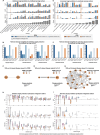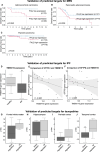Therapeutic target prediction for orphan diseases integrating genome-wide and transcriptome-wide association studies
- PMID: 40251160
- PMCID: PMC12008218
- DOI: 10.1038/s41467-025-58464-4
Therapeutic target prediction for orphan diseases integrating genome-wide and transcriptome-wide association studies
Abstract
Therapeutic target identification is challenging in drug discovery, particularly for rare and orphan diseases. Here, we propose a disease signature, TRESOR, which characterizes the functional mechanisms of each disease through genome-wide association study (GWAS) and transcriptome-wide association study (TWAS) data, and develop machine learning methods for predicting inhibitory and activatory therapeutic targets for various diseases from target perturbation signatures (i.e., gene knockdown and overexpression). TRESOR enables highly accurate identification of target candidate proteins that counteract disease-specific transcriptome patterns, and the Bayesian optimization with omics-based disease similarities achieves the performance enhancement for diseases with few or no known targets. We make comprehensive predictions for 284 diseases with 4345 inhibitory target candidates and 151 diseases with 4040 activatory target candidates, and elaborate the promising targets using several independent cohorts. The methods are expected to be useful for understanding disease-disease relationships and identifying therapeutic targets for rare and orphan diseases.
© 2025. The Author(s).
Conflict of interest statement
Competing interests: The authors declare no competing interests.
Figures





Similar articles
-
Predicting inhibitory and activatory drug targets by chemically and genetically perturbed transcriptome signatures.Sci Rep. 2018 Jan 9;8(1):156. doi: 10.1038/s41598-017-18315-9. Sci Rep. 2018. PMID: 29317676 Free PMC article.
-
rvTWAS: identifying gene-trait association using sequences by utilizing transcriptome-directed feature selection.Genetics. 2024 Feb 7;226(2):iyad204. doi: 10.1093/genetics/iyad204. Genetics. 2024. PMID: 38001381
-
How powerful are summary-based methods for identifying expression-trait associations under different genetic architectures?Pac Symp Biocomput. 2018;23:228-239. Pac Symp Biocomput. 2018. PMID: 29218884 Free PMC article.
-
Human Genetics and Genomics for Drug Target Identification and Prioritization: Open Targets' Perspective.Annu Rev Biomed Data Sci. 2024 Aug;7(1):59-81. doi: 10.1146/annurev-biodatasci-102523-103838. Epub 2024 Jul 24. Annu Rev Biomed Data Sci. 2024. PMID: 38608311 Review.
-
Genome-Wide Association Study Statistical Models: A Review.Methods Mol Biol. 2022;2481:43-62. doi: 10.1007/978-1-0716-2237-7_4. Methods Mol Biol. 2022. PMID: 35641758 Review.
References
-
- Arrowsmith, J. & Miller, P. Trial Watch: Phase II and Phase III attrition rates 2011-2012. Nat. Rev. Drug Discov.12, 569 (2013). - PubMed
-
- He, H., Liu, L., Morin, E. E., Liu, M. & Schwendeman, A. Survey of clinical translation of cancer nanomedicines - lessons learned from successes and failures. Acc. Chem. Res.52, 2673–2683 (2019). - PubMed
-
- Plenge, R. M. Disciplined approach to drug discovery and early development. Sci. Transl. Med. 8, 349ps15 (2016). - PubMed
MeSH terms
Grants and funding
LinkOut - more resources
Full Text Sources
Medical

